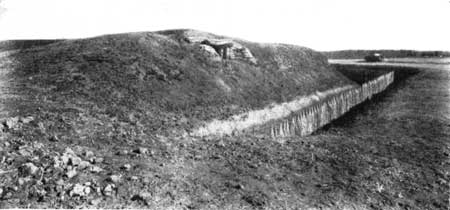MENU
|
Glimpses of Historical Areas East of the Mississippi River |
|
The War Between the States |
|
VIRGINIA |
Special Feature: Scene of a number of battles and military movements in the defense of Richmond during the War Between the States.

Restored Fort Harrison, Richmond National
Battlefield Park.
RICHMOND NATIONAL BATTLEFIELD PARK presents the story of military conflict involving the methods of both open and siege warfare; a story of a 4-year effort on the part of Union armies to take the Confederate capital. Massive fortifications where men lived under conditions of trench warfare and open fields where desperate charges were made embody a long, stirring narrative of military operations.
Owned until recently by the Commonwealth of Virginia, the park was placed under the care of the National Park Service, Department of the Interior, in 1933, and later was offered to the Nation as a national park. The act of Congress authorizing the acceptance of the area and its establishment as a national battlefield park was signed by President Franklin D. Roosevelt on March 2, 1936.
For 4 years, from 1861 to 1865, Richmond was almost constantly an embattled city. The capital of the Confederate States of America was always the objective of the Army of the Potomac. Battles were fought almost in the shadow of the city in 1862 and again in 1864.
McClellan's ill-starred peninsular campaign in the spring and summer of '62 brought to the very portals of Richmond battles surpassing in magnitude any previously fought in the Western Hemisphere. On May 31, 1862, the Battle of Seven Pines proved to the Army of the Potomac the immense difficulties that would be involved in the attempt to continue its march up the peninsula between the James and York Rivers into Richmond. When the blue and the grey forces next clashed it was Lee against McClellan. This time McClellan was on the defensive. He had delayed too long before the city. Lee had gathered his strength and had come out from the ramparts to drive the invader away. The Southern commander hurled his troops against the Army of the Potomac at Mechanicsville on June 26. McClellan repulsed him, but fell back that night to Gaines' Mill, where the next day he received an assault delivered with such violent impact that he was compelled to begin a hasty though masterfully organized retreat to the James River.
In rapid succession followed the bitterly contested battles of Savage's Station, Frazier's Farm, and, on July 1, Malvern Hill. Only McClellan's skillful handling of his unwieldy masses in retreat, combined with the ever-recurrent accidents of warfare, saved the Army of the Potomac from annihilation. These Seven Days' Battles soon were followed by the withdrawal of McClellan's troops from the James River in transports, and the people of Richmond once more felt secure.
Two years elapsed before the Northern forces were able again to threaten seriously the Confederate Capital. Grant had been transferred from the West to lead the Federal armies in Virginia as he had shown himself to be one of the few Northern commanders able to cope successfully with the Southern armies. After staggering blows delivered at the Confederate lines in the Wilderness and at Spotsylvania Courthouse, in early June 1864, he faced Lee at Cold Harbor. At dawn on June 3, he launched a mighty attack along the full length of a 6-mile front. Within 10 minutes it had been repulsed with such savage finality that the battle was virtually over and about 10,000 of the assailants had been killed or wounded. Again one of Grant's sledge-hammer blows had failed to crack the Confederate defenses. In one of the most skillful maneuvers of the war, Grant then quickly crossed the James River and laid siege to Petersburg, seeking a way into Richmond through the back door. Only once thereafter did Lee's great antagonist seriously attempt a frontal assault on the capital of the Confederacy. His goal was almost gained when, on September 29, he sent two corps of the Army of the James across the river to attack Fort Harrison, which was on a road leading directly into Richmond. But the heavy fortifications, thrown up after McClellan's threat and the timely arrival of Confederate reinforcements once more saved the city. On April 2, 1865, when Petersburg had been enveloped and the lines of communications toward the South had been severed, Grant's forces entered Richmond and Petersburg as those of Lee evacuated those two cities.
The scenes of these heroic struggles are preserved in the Richmond National Battlefield Park. There the visitor will find historic ground rich in its narrative of deeds which form a glowing panel in the tapestry of American history.
A feature of the park is the reconstructed Fort Hoke, one of the strong redoubts on the Fort Harrison line, wherein there is presented for the visitor a Civil War fort, precisely as it existed when it was a center of fighting. The various types of gun positions, revetments, and obstructions have been reconstructed in strict accordance with the working plans used by the military engineers of 1861-65. The massive earthworks there and elsewhere along this front line of the Richmond defenses are remarkably well preserved, and in them the visitor finds a stirring story of long-continued defense and attack.
The park area contains terrain pleasantly relieved by ravines and hills, with large stretches of deep cool woods which invite the camper and picnicker. Good roads give access to the massive earthworks, and bridle trails and footpaths are being constructed through areas of woodland charm to points of historic interest and to camp and picnic grounds.
NEXT> Antietam National Battlefield Site
 Top
Top
Last Modified: Thurs, Nov 23 2000 10:00:00 pm PDT
http://www.cr.nps.gov/history/online_books/glimpses3/glimpses4k.htm
![]()
